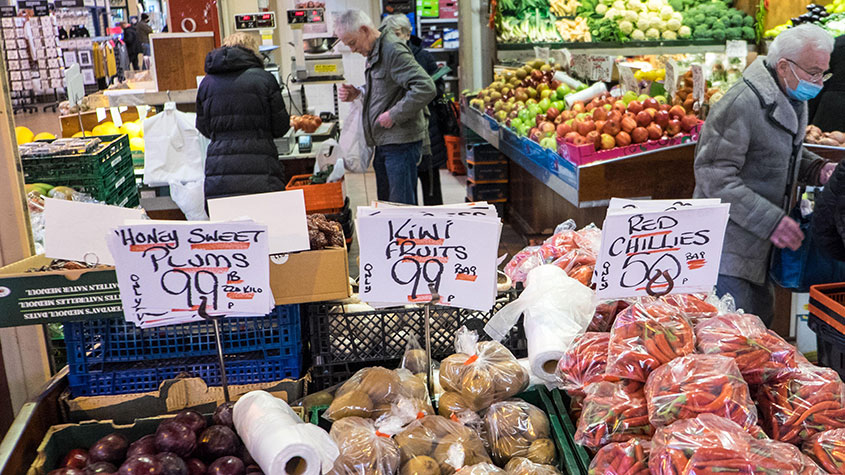Why do we use the weights and measures we do?
The UK uses a particularly quirky mix of imperial and metric measures, and the subject of which is best can provoke considerable ire. Here, Dominic Frisby explains how each system came about, and the benefits of both.


The Edinburgh Fringe Festival starts this week. It’s the world’s biggest arts festival, an event that sells more tickets than any other event in the world, with the exception of the Olympic Games.
I shall be making my way up to Scotland’s capital to make my own little contribution, a new show that I haven’t finished writing yet (!), “a lecture with funny bits”, about the eternal subject that is weights and measures.
Why do I say eternal?
MoneyWeek
Subscribe to MoneyWeek today and get your first six magazine issues absolutely FREE

Sign up to Money Morning
Don't miss the latest investment and personal finances news, market analysis, plus money-saving tips with our free twice-daily newsletter
Don't miss the latest investment and personal finances news, market analysis, plus money-saving tips with our free twice-daily newsletter
Because people have been arguing about them, and trying to impose them since forever.
How French revolutionaries tried to decimalise time
The very first legal documents we have from Ancient Mesopotamia depict rulers with the rod and ring – a yardstick and a measuring string – usually being handed to them by God, as they try and standardise measures in law. Ancient Egyptian documents, illustrations and hieroglyphs abound with similar references. Scales are prominent too.
The opening words of the Bible establish our basic measures of time – the day and the week.
This is something the French Revolutionaries tried to do away with in 1792 when they decimalised time.
One week would be ten days. One day would be ten hours. One hour would contain 100 decimal minutes, and each decimal minute, 100 decimal seconds. Thus one day would be 100,000 decimal seconds per day.
When the proles discovered that meant one day off in ten, rather than in seven, the system began to meet with considerable resistance and was kicked out. The revolutionaries may have got their metric weights and distances over the line, but time was a step too far.
What is a “step” by the way, but a measure? A vague but useful measure that fitbits and iPhones and health apps have become obsessed with. I did 14,126 steps yesterday (it was a long day). What about you?
“There is to be one measure of wine throughout our kingdom, and one measure of ale, and one measure of corn,” proclaims Magna Carta. “One breadth of cloths … and let weights be dealt with as with measures.”
Even today, when Boris Johnson made announcements about being able to use imperial measures again, the culture wars kicked off. In his 2019 election manifesto Johnson pledged “an era of generosity and tolerance towards traditional measurements”. To the Guardian, however, this was xenophobia and pseudoscience.
Which is best – “free market” imperial or “central planning” metric?
I often go to the Edinburgh Fringe to do “lectures with funny bits”.
In 2016 I did one about tax, which would eventually become my book Daylight Robbery. In 2019, I did one about the philosophies of Adam Smith and how they related to the economics of the Fringe, which would eventually become a film, Father of the Fringe.
This time around I thought it would be interesting to do one about weights and measures. I’ve since discovered the subject is enormous and endless, which is why I haven’t finished writing it yet. (It’s going to be held in Adam Smith’s old front room at Panmure House, so a wonderful historic setting.)
The inevitable question that gets asked is: which system is better – imperial or metric? I would answer, with the bland neutrality of the on-the-fence politician, that they both have their place.
I grew up with the metric system. That was what I was taught at school. But as I’ve grown older, I’ve found myself thinking more and more in imperial.
Feet make more sense to me than 30, 60, or 90 centimetres, or 1.2, 1.5 or 1.8 metres. Inches – a thumb pressed down – make more sense than centimetres. A hair’s breadth means more than a micrometre.
I find it easier to orient myself around pints than I do litres, around pounds – the amount you can easily hold in your hand – than I do kilos, and around yards – a pace – than I do metres.
But the problem with imperial is that it was never a designed system in the way that metric is. Most measures emerged over time through use. Impractical measures got abandoned, and practical ones stuck.
The buku was the distance from which the cry of a buffalo could be heard in Russia. No doubt an extremely useful measure in a country with such vast expanses of land, but of little use today.
The pound we use today, however, roughly corresponds with the Babylonian “mesa”. Shoe sizes are defined by barleycorns. A fathom is one’s arms outstretched – six feet. A really useful distance, especially for depth.
But there are a gazillion measures that found common use in history that have fallen by the wayside. It’s very much a market driven system.
Yet as soon as you start to analyse it with the logic of the planner, imperial measures look nuts. Just take a look at some of the flow charts to explain imperial measures on Wikipedia and elsewhere if you want to understand how nuts it looks.
Why can’t we just have both?
Americans have a “dry gallon” and a “liquid gallon”. What’s more, their gallon is not the same as our imperial gallon (one of the reasons petrol there seems SO much cheaper is that their gallon is smaller). But their gallon is the English gallon because they use the English system, which came over with the settlers.
We British, however, use the imperial system with the Weights and Measures Act of 1824, long after US independence, and exported through the Empire, in part to make sure this new-fangled French metric system didn’t take hold.
This new-fangled French metric system came about with the French Revolution. “One king, one law, one weight, one measure,” the Revolutionaries cried. They had, according to the BBC, some 250,000 different weights and measures – differing from town to town and district to district (talk about regional diversity) – and there was considerable fraud.
Let us give them “a system for all people for all time” thought the savants, the 18th-century liberal metropolitan elite. Instead of defining measures around the human body and the immediate world around us, they thought, we will design a system around the earth itself. A metre will be one ten millionth of the distance from the North Pole to the equator.
So two scientists were sent out to measure the distance from Dunkirk to Barcelona and they would extrapolate it from there. However, one of the scientists, who got arrested for sorcery, then for spying and then saw his money disappear with the hyperinflation of the assignat, under considerable pressure, fudged the data and so the measure is actually wrong. By how much? A hair’s breadth.
The metre has since been redefined, first around the speed of light and then around atomic movements, to give it a level of precision the ordinary yard – a pace – will never have. But those redefinitions have always used as their base that first metre which was erroneous and, slightly, fraudulent.
We do need one international system of measures that everyone understands, especially for science.
But, in the same way it is good to speak more than one language, so should we be familiar with more than one system of measurement. And if you want regional diversity, especially in architecture, then you should embrace diversity of measurement.
Today the only countries in the world not officially on the metric system are Myanmar, Liberia and the US. But on the ground, traditional measures are used everywhere - from the prevalent half kilo, effectively a pound, to brick sizes (a hand) to cargo ships. People talk and think in traditional measures, because they are practical and rooted in the world around us. Metric is abstract. Long live both.
Dominic Frisby’s How Heavy?, a lecture with funny bits about weights and measures, will be running at the Edinburgh Fringe from August 7-15. You can get tickets here.
Get the latest financial news, insights and expert analysis from our award-winning MoneyWeek team, to help you understand what really matters when it comes to your finances.
Dominic Frisby (“mercurially witty” – the Spectator) is as far as we know the world’s only financial writer and comedian. He is the author of the popular newsletter the Flying Frisby and is MoneyWeek’s main commentator on gold, commodities, currencies and cryptocurrencies. He has also taken several of his shows to the Edinburgh Festival Fringe.
His books are Daylight Robbery - How Tax Changed our Past and Will Shape our Future; Bitcoin: the Future of Money? and Life After the State - Why We Don't Need Government.
Dominic was educated at St Paul's School, Manchester University and the Webber-Douglas Academy Of Dramatic Art.
You can follow him on X @dominicfrisby
-
 London claims victory in the Brexit wars
London claims victory in the Brexit warsOpinion JPMorgan Chase's decision to build a new headquarters in London is a huge vote of confidence and a sign that the City will remain Europe's key financial hub
-
 The reinvention of the high street – and how to invest
The reinvention of the high street – and how to investThe high street brands that can make shopping and leisure an enjoyable experience will thrive, says Maryam Cockar
-
 UK wages grow at a record pace
UK wages grow at a record paceThe latest UK wages data will add pressure on the BoE to push interest rates even higher.
-
 Trapped in a time of zombie government
Trapped in a time of zombie governmentIt’s not just companies that are eking out an existence, says Max King. The state is in the twilight zone too.
-
 America is in deep denial over debt
America is in deep denial over debtThe downgrade in America’s credit rating was much criticised by the US government, says Alex Rankine. But was it a long time coming?
-
 UK economy avoids stagnation with surprise growth
UK economy avoids stagnation with surprise growthGross domestic product increased by 0.2% in the second quarter and by 0.5% in June
-
 Bank of England raises interest rates to 5.25%
Bank of England raises interest rates to 5.25%The Bank has hiked rates from 5% to 5.25%, marking the 14th increase in a row. We explain what it means for savers and homeowners - and whether more rate rises are on the horizon
-
 UK inflation remains at 8.7% ‒ what it means for your money
UK inflation remains at 8.7% ‒ what it means for your moneyInflation was unmoved at 8.7% in the 12 months to May. What does this ‘sticky’ rate of inflation mean for your money?
-
 Would a food price cap actually work?
Would a food price cap actually work?Analysis The government is discussing plans to cap the prices of essentials. But could this intervention do more harm than good?
-
 Is my pay keeping up with inflation?
Is my pay keeping up with inflation?Analysis High inflation means take home pay is being eroded in real terms. An online calculator reveals the pay rise you need to match the rising cost of living - and how much worse off you are without it.
